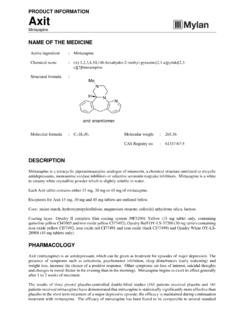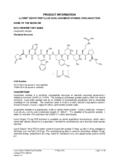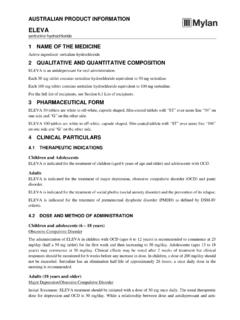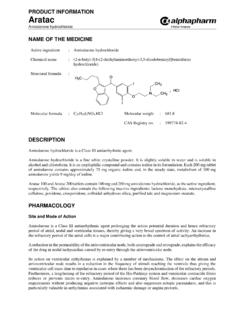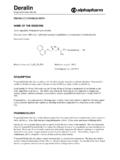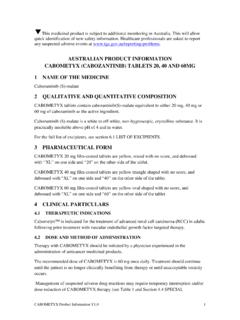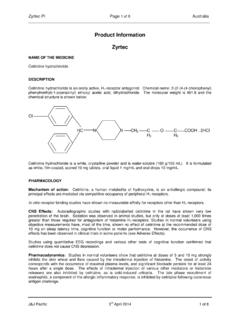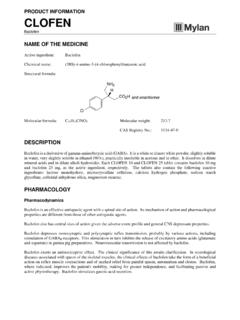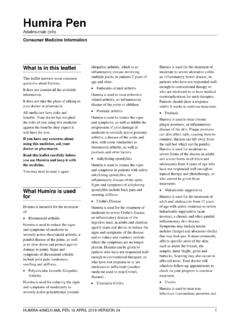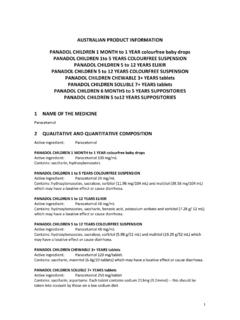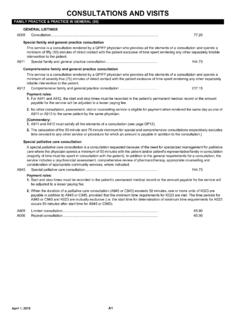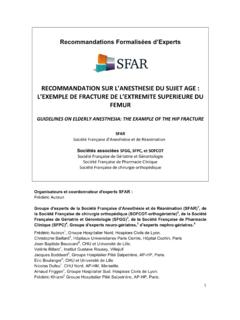Transcription of Bicor - Medicines
1 Bicor Bisoprolol fumarate PRODUCT INFORMATION NAME OF THE MEDICINE Active ingredient: Bisoprolol fumarate Chemical name: (RS)-1-[4-[[2-(1-Methylethoxy)ethoxy]met hyl]phenoxy]-3-[(1-methylethyl)amino]pro pan-2-ol fumarate Structural formula: Molecular formula: C40H66N2O12 Molecular weight: 767 CAS Registry no: 104344-23-2 DESCRIPTION Bisoprolol fumarate is a white crystalline substance with a melting range of 100-104 C. It is very soluble in water and methanol, freely soluble in ethanol, glacial acetic acid and chloroform. As the substance is present in the form of a racemate, the aqueous solution does not show optical activity. With the underlying manufacturing conditions no polymorphic forms were observed. Each Bicor mg (Starter pack) tablet contains mg of bisoprolol fumarate.
2 The tablets also contain the following inactive ingredients: colloidal anhydrous silica, magnesium stearate, crospovidone, pregelatinised maize starch, maize starch, microcrystalline cellulose, anhydrous calcium hydrogen phosphate, dimethicone 100, purified talc, macrogol 400, titanium dioxide and hypromellose. Each Bicor mg tablet contains mg of bisoprolol fumarate. The tablets also contain the following inactive ingredients: colloidal anhydrous silica, magnesium stearate, crospovidone, maize starch, microcrystalline cellulose, anhydrous calcium hydrogen phosphate, dimethicone 100, macrogol 400, titanium dioxide and hypromellose. Each Bicor mg, 5 mg, mg and 10 mg tablet contains the specified quantity of bisoprolol fumarate.
3 The tablets also contain the following inactive ingredients: colloidal anhydrous silica, magnesium stearate, crospovidone, maize starch, microcrystalline cellulose, anhydrous calcium hydrogen phosphate, dimethicone Bicor Product Information 2 100, macrogol 400, titanium dioxide, iron oxide yellow (CI 77492) and hypromellose. Bicor 10 mg tablets also contain iron oxide red (CI 77491). PHARMACOLOGY Pharmacodynamics Bisoprolol is a 1-selective-adrenoceptor blocking agent, lacking intrinsic stimulating and relevant membrane stabilising activity. It only shows very low affinity to the 2-receptor of the smooth muscles of bronchi and vessels as well as to the 2-receptors concerned with metabolic regulation.
4 Therefore, bisoprolol is generally not to be expected to influence the airway resistance and 2-mediated metabolic effects. Its 1-selectivity extends beyond the therapeutic dose range. However, its 1-selectivity is not absolute and at doses greater than the maximum recommended of 10 mg, bisoprolol may also inhibit 2-adrenoreceptors The haemodynamic effects of bisoprolol are those that can be expected from -adrenoceptor blockade. Besides the negative chronotropic effect resulting in a reduction in resting and exercise heart rate there is, as shown in acute studies with iv administration, a fall in resting and exercise cardiac output with only little change in stroke volume, and a small increase in right atrial pressure at rest or during exercise.
5 The decrease in cardiac output correlates with the heart rate reduction, and the observed increases in total peripheral resistance and pulmonary arterial resistance after acute administration are considered to be due to reflex autonomic changes resulting from the negative chronotropic and slight negative inotropic effects. Acute iv administration of 10 mg bisoprolol to hypertensive patients reduced glomerular filtration rate (GFR), renal blood flow (RBF) and plasma renin activity (PRA) whereas the renal vascular resistance was reduced after short-term treatment (10 mg bisoprolol po for 4 weeks) with no significant changes in RBF, GFR or PRA. Epinephrine and norepinephrine levels also remained unaffected after the 4-week treatment in hypertensive patients.
6 Bisoprolol shows the same pattern of cardiac electrophysiologic effects as other -adrenoceptor blocking agents. It acts on those parts of the conduction system that are influenced by the sympathetic nervous system. In electrophysiological studies it reduced heart rate, prolonged SA and AV nodal conduction, and prolonged the refractory periods of the SA and AV node. There was no statistically significant effect on atrial effective refractory period in patients with a history of syncope or cardiac arrhythmias. However, in patients with coronary artery disease, there was a small significant increase in right atrial effective and functional refractory periods. Right ventricular effective refractory period was temporarily prolonged during a study in patients with coronary artery disease, but the clinical relevance of the small increase is uncertain.
7 RR and PR intervals were increased and QTc intervals reduced but all parameters remained within normal limits after bisoprolol. Pharmacokinetics Absorption. Bisoprolol is almost completely (>90%) absorbed from the gastrointestinal tract and, because of its small first pass metabolism of about 10%-15%, has an absolute bioavailability of about 85-90% after oral administration. The bioavailability is not affected by food. The drug shows linear kinetics and the plasma Bicor Product Information 3 concentrations are proportional to the administered dose over the dose range 5 to 20 mg. Peak plasma concentrations occur within 2-3 hours. Distribution. Bisoprolol is extensively distributed. The volume of distribution is L/kg.
8 Binding to plasma proteins is approximately 35%; uptake into human blood cells was not observed. Metabolism. In humans, only oxidative metabolic pathways have been detected with no subsequent conjugation. All metabolites, being very polar, are renally eliminated. The major metabolites in human plasma and urine were found to be without pharmacological activity. In vitro data from studies in human liver microsomes show that bisoprolol is primarily metabolized via CYP3A4 (~95%) with CYP2D6 having only a minor role. The minor contribution of CYP2D6 to the metabolism of bisoprolol observed in vitro is consistent with the in vivo data in extensive and restricted debrisoquine metabolisers, which showed no difference between the two groups of metabolisers.
9 Bisoprolol is a racemate consisting of the R and S enantiomers. The intrinsic clearance by human recombinant CYP3A4 appears to be non-stereoselective while the metabolism by CYP2D6 is stereoselective (R/S = ). Elimination. The clearance of bisoprolol is 'balanced' between renal elimination of the unchanged drug (~50%) and hepatic metabolism (~50%) to metabolites which are also renally excreted. The total clearance of the drug is L/h with renal clearance being L/h. In a study with 14C-labelled bisoprolol the total urinary and fecal excretion was 90 and of the dose, respectively (mean SEM recoveries of the total dose within 168 hours). Bisoprolol has an elimination half-life of 10-12 hours. Renal Impairment.
10 Since the clearance of bisoprolol is balanced between renal and hepatic mechanisms, the plasma accumulation factor of bisoprolol in patients with either complete renal or hepatic impairment should not exceed 2. In a study in patients with a mean creatinine clearance of 28 mL/min, the plasma accumulation factor was less than 2, and it has been shown that as the creatinine clearance falls the AUC increases as does the t and Cmax. According to these studies in patients with renal impairment no dosage adjustment is normally required up to the maximum dose of 10 mg bisoprolol. Hepatic Impairment . There were no clinically relevant differences in the pharmacokinetics of bisoprolol between patients with normal or impaired hepatic function.
